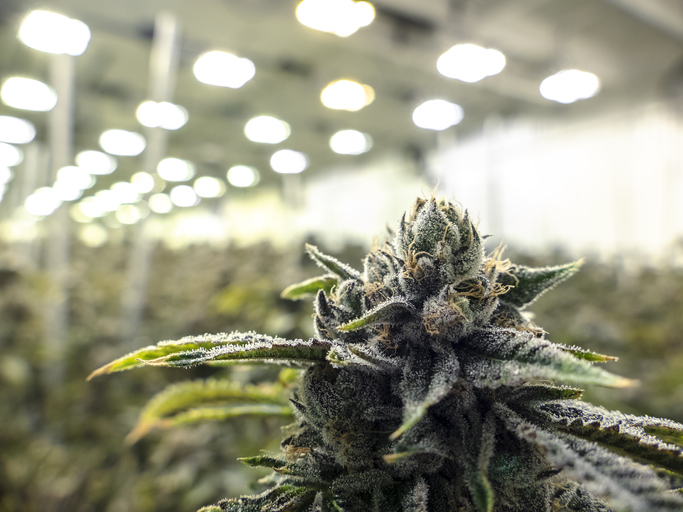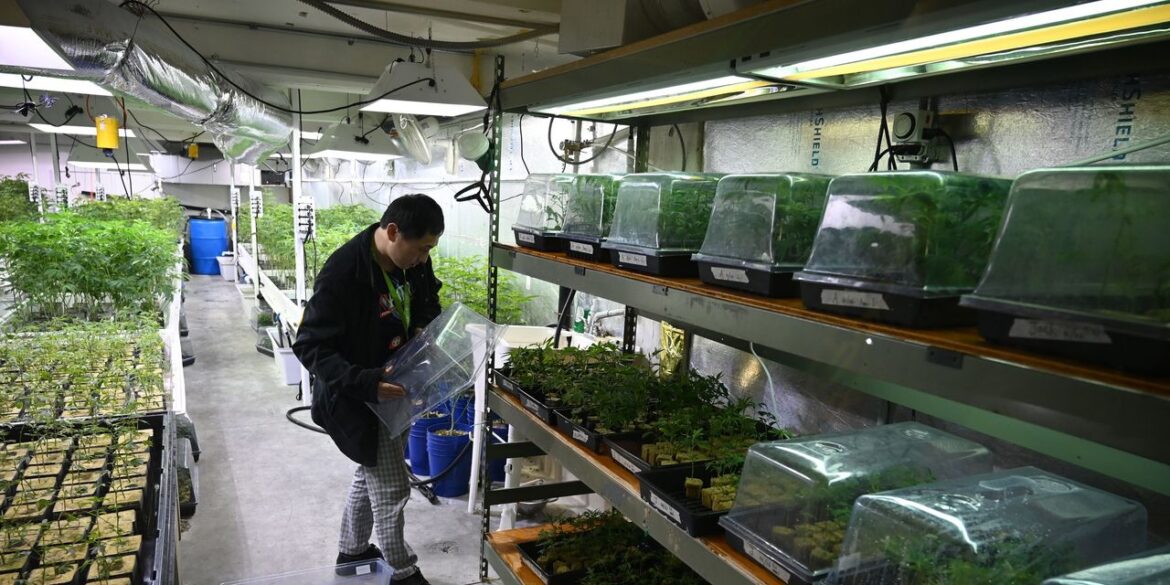
The stock rose another 35% on Friday after Germany voted to decriminalize cannabis.
Source link
Canopy
Do Canopy Growth’s Improved Q3 Numbers Give Investors Hope for a Turnaround?
It hasn’t been a great start to the year for cannabis producer Canopy Growth (CGC 6.41%), as its shares are already down 29% this year. The stock has struggled to win over investors in recent years. A highly competitive Canadian cannabis market has made it difficult for the company to grow without burning through cash and incurring hefty losses along the way.
Earlier this month, the company released its latest quarterly results, which showed a significant improvement in the bottom line. Does this indicate something positive, that perhaps the stock can finally turn things around this year?
A closer look at how Canopy Growth performed in Q3
For the last three months of 2023, Canopy Growth reported net revenue of 78.5 million Canadian dollars, which was down 7% on a year-over-year basis. A big part of the reason for the decline in the top line was that the company has gotten smaller by divesting its sports nutrition business BioSteel, which Canopy Growth previously said was a significant drain on cash.
The company has been focusing on becoming leaner in an effort to slow its cash burn and improve profitability. Last quarter, Canopy Growth’s adjusted earnings before interest, taxes, depreciation, and amortization (EBITDA) loss of just under CA$9 million was much smaller than the CA$49.7 million adjusted EBITDA loss it incurred a year earlier. Its free cash flow for the quarter was a negative CA$33.9 million, which was also an improvement from the prior-year period when Canopy Growth’s free cash was a negative CA$78.9 million.
Overall, it was an improved quarter for Canopy Growth, but investors seem uninspired by the company’s latest update.
Canopy USA remains the focal point of its strategy
For years, the big draw for investing in Canopy Growth has been that it would be ready to move into the U.S. pot market once it’s legal to do so. It has reached tentative deals with Acreage Holdings, Wana Brands, and other U.S.-based cannabis companies that it hasn’t been able to close on due to the federal ban on pot in the U.S.
Marijuana legalization isn’t on the horizon in the U.S., so Canopy Growth is doing the next best thing: Creating a special purpose vehicle for all the pending deals it has with U.S.-based companies, called Canopy USA. There is a shareholder vote scheduled for April 12, which, if successful, will move things forward and pave the way for the creation of a new class of non-voting, non-participating exchangeable shares.
Canopy Growth says it expects “to be the first and only U.S. listed company offering shareholders a unique opportunity to gain exposure to the fastest growing cannabis market in the world.” It will have a non-controlling interest in the entity, and it will be an “unconsolidated investment.” The Nasdaq exchange had previously objected to Canopy Growth consolidating the results of U.S.-based cannabis companies, which is why investors shouldn’t expect to see those results pad up Canopy Growth’s own numbers anytime soon.
My concern as an investor would be that Canopy Growth continues paying too much attention to a market that is unavailable and is likely to continue to be unavailable to the Canadian pot producer for the foreseeable future. Spending time and money on this elaborate setup for Canopy USA in the hopes of someday being able to capitalize on those opportunities doesn’t seem like a great use of resources, especially since Canopy Growth’s financials still need lots of work to get to breakeven and for this to be a viable investment.
Not enough has changed (improved) for Canopy Growth stock to be a buy
Canopy Growth investors only need to look to rival Aurora Cannabis as proof that even achieving positive adjusted EBITDA may not be enough to turn things around for the troubled pot stock. Aurora has posted an adjusted EBITDA profit for five straight quarters, and that hasn’t resulted in a significant rally.
Investors have simply lost trust in these companies, and rightly so. Even if Canopy Growth gets to breakeven, its strategy for long-term growth is questionable, given that the U.S. doesn’t look like it’s legalizing marijuana in the near future. And that would need to happen for investors to become bullish on the company’s long-term growth opportunities.
Although Canopy Growth’s financials are improving, there’s still not a compelling enough reason to invest in the stock, as it could still be a tough road ahead for investors.
If You Invested $5,000 in Canopy Growth in 2018, This Is How Much You Would Have Today
Of the many varied and captivating businesses in the cannabis sector, Canopy Growth (CGC 1.54%) is one of the more dynamic competitors. With the company recently abandoning its home market to try to enter the U.S., core elements of its strategy and positioning are still in flux. That makes now an interesting, if significantly riskier, time to invest.
But how did the shareholders of the past fare with their investment? Let’s settle this issue by calculating how much a $5,000 investment in this company made five years ago would be worth today. Then, we’ll assess its probable future trajectory to see if it’s appealing to purchase.
It’s been a brutal ride
The five years between December 2018 and today have been difficult for Canopy for several reasons. First, it overextended itself when trying to seize market share in the hot Canadian cannabis market throughout 2019 and 2020, building up too many manufacturing facilities and retail outlets for the long-term level of demand. That set it up for deep unprofitability, which has proven quite hard to shake despite efforts to shed excessive overhead and orient itself toward the markets where it expects to see the most growth.
For management, the growth market was clearly the U.S. rather than Canada, as cannabis legalization could provide a major catalyst in the U.S. if it ever happens. Canopy’s strategy was thus to arrange a series of acquisitions of U.S.-based operators via a parallel holding company while exiting its Canadian retail operations. That hasn’t gone as planned. Though its retail outlets are gone, its access to the U.S. market remains stymied in a regulatory limbo, and full legalization is nowhere in sight either. It’s still selling off unprofitable business units in an attempt to bring its expenses in line with revenue.
With so many setbacks, it’s no surprise that the stock hasn’t performed well. If you’d made an investment of $5,000 in Canopy Growth stock in late 2018, today you’d have a grand total of $93, after suffering a brutal decline of more than 98%. But the stock’s trajectory wasn’t exactly an uninterrupted slow collapse, nor was it a rapid crash. Instead, shareholders experienced two big run-ups where their shares would have been worth around $8,000 at each peak. Since the second peak, in early 2021, it’s all been downhill, and over the last three months alone, the stock fell 51%.
Will the future be better?
We’ve established that Canopy Growth has been a money-burning investment for long-term shareholders. But after losing so much of its value, could it be the case that things will eventually start to look up once again?
Unfortunately, it doesn’t look good right now. The company’s drive toward efficiency has occurred at the cost of missing out on revenue. Its trailing 12-month (TTM) sales fell by 31% over the past three years, reaching $262 million. It remains deeply unprofitable, and there is no indication that any of its products are popular enough to constitute a competitive advantage that can prevent its market share from being stolen by other players. Its share price is now so low that it just completed a reverse stock split to stay listed on exchanges and keep its share price above $1.
Even if cannabis were federally legalized the U.S. tomorrow, Canopy Growth would be at risk of making the same mistakes it did in Canada, and profitability would be even further away.
Its TTM operating expenses are $268 million, and its cash and short-term investments total only $199 million. In other words, it probably needs to shrink more to stay alive. It’s hard to imagine how the next five years could be as bad for shareholders as the last five were, but without significant changes, there’s a good chance that the future will be almost as difficult as the past.
Alex Carchidi has no position in any of the stocks mentioned. The Motley Fool has no position in any of the stocks mentioned. The Motley Fool has a disclosure policy.
Shares of Canopy Growth (CGC 13.97%) are down 13% this week as of Thursday’s close, according to data provided by S&P Global Market Intelligence, after the cannabis producer completed a reverse-stock split and completed the divestment of a small subsidiary business.
Canopy Growth’s share consolidation just took effect
Recall Canopy Growth stock also plunged more than 35% last week when the company unveiled the structure of the then-pending 1-for-10 “share consolidation,” otherwise known as a reverse-stock split. Canopy Growth’s consolidation officially took effect before the market opened yesterday (Dec. 20), reducing the number of outstanding shares by a factor of 10 while increasing the per-share price of its new common shares by the same multiple.
But why did Canopy Growth need to make this move in the first place? According to the rules of the Nasdaq exchange on which Canopy Growth stock trades, any stock that closes below $1 per share for 30 consecutive business days risks being delisted, though stocks in violation of the rule can also regain compliance by closing at or above $1 per share for 10 consecutive trading days. Canopy Growth shares had plunged more than 70% year to date at the time of last week’s announcement and had hovered below the $1 mark since the middle of September 2023.
Canopy closed today at $4.51 per share following the consolidation. So, barring a nearly 80% drop from these levels, Canopy Growth should have little trouble regaining compliance with the Nasdaq exchange by remaining above $1 per share for the next eight trading days.
Why Canopy Growth needs to show progress
It’s worth revisiting, of course, why Canopy Growth investors were upset by this particular share consolidation. Reverse splits are typically a zero-sum game, with the value of investors’ stakes remaining the same through the process. But Canopy Growth’s share consolidation deviated from the norm in that the company decided not to compensate investors for any fractional shares arising from the consolidation.
For example, in a typical 1-for-10 reverse split, an investor who held 19 shares of a stock trading at $0.52 per share would be given a single share worth $5.20, as well as $4.68 in cash for their remaining nine shares at $0.52 apiece. But with Canopy Growth’s consolidation structure, the same investor would have exchanged 10 original shares for a single new share worth $5.20 and received nothing for their other nine original shares.
Canopy Growth must also show sustained progress in its underlying business in order to avoid once again falling below the $1 per-share level in the future.
To that end, on Monday Canopy Growth announced that it has completed the roughly $12 million sale of its “This Works” skincare and wellness brand. The move should help Canopy Growth hone its focus on its core North American cannabis market, while transforming it into what CEO David Klein describes as “a simplified, asset-light, cannabis focused business.”
In the meantime, however, given the risk that its transformation won’t unfold as planned, and as the market digests the shareholder-unfriendly nature of its reverse split, it’s no surprise to see Canopy Growth continuing to pull back this week.
Tilray Brands vs. Canopy Growth: Which Cannabis Company Has the Better Long-Term Strategy?
The cannabis industry in Canada is in shambles. Pick a random pot stock and you’re sure to find an investment that is down big over the past few years. Canopy Growth (CGC -1.05%) and Tilray Brands (TLRY -2.79%) are no exception — they’ve fallen more than 50% in just the past 12 months. These businesses are struggling to grow and they are finding it difficult to reach breakeven. Their strategies, however, for fixing their problems vary. Which company is on the better path?
The case for Canopy Growth
Canopy Growth is hunkering down in an effort to streamline its operations and conserve cash as best as it can. The company has been laying off staff this year and it has even sold off its facility in Smiths Falls, Ontario, which served as its headquarters. It has also divested its retail operations in Canada.
Canopy Growth now likes to mention that it’s transitioning to an “asset-light model,” which is a much nicer way of saying that it’s looking to cut whatever it can to bring down expenses. But that’s what it needs to do if it wants to execute on some aggressive long-term plans.
Canopy Growth has been eager to enter the U.S. pot market for years; in 2019 it first revealed plans to acquire multi-state marijuana company Acreage Holdings. And since then, it has announced plans to work with Wana Brands and Jetty Extracts. But it can’t close on those deals with marijuana still not legal in the U.S.
Canopy Growth is effectively in a bit of a holding pattern right now. Legalization doesn’t appear imminent by any stretch, and the Nasdaq has also pushed back on the company’s plans to consolidate and report on the performance of U.S. assets. By trimming its costs and making the business leaner, it can help make its cash last longer, potentially reducing the need to raise capital in the near future.
In the three-month period ended June 30, Canopy Growth burned through 148.7 million Canadian dollars ($108 million) over the course of its day-to-day operating activities. That’s worse than the CA$140.5 million cash burn it reported a year ago. But with the company no longer planning to fund its cash-burning nutritional business, BioSteel, that should slow the rate of cash burn down. As of the end of June, Canopy Growth had cash and cash equivalents totaling CA$533 million, which could last more than a year if its cash burn slows down.
Canopy Growth’s plans to get leaner can help the business at a time when being large in the highly competitive Canadian cannabis industry isn’t necessarily a good thing. And improving its financials can put it in a good position to pursue growth opportunities in the U.S., if and when they open up.
The case for Tilray Brands
While Canopy Growth has been getting leaner, Tilray Brands has been in acquisition mode and diversifying its operations. One area that has been of particular focus for the business is alcohol. In August, the company announced it was going to acquire eight beverage brands from Anheuser-Busch InBev in a bid to expand its presence in the U.S. and its alcohol business. As a result of the deal, Tilray Brands projects it will hold 5% of the market for craft beer in the U.S.
Diversifying into alcohol is a good move for Tilray because it can help improve its bottom line. Here’s a comparison of the company’s gross margin by segment in its most recent quarter, which ended in August:
| Segment | Revenue | Gross Margin |
|---|---|---|
| Cannabis | $70.3 million | 28% |
| Beverage | $24.2 million | 53% |
| Distribution | $69.2 million | 11% |
| Wellness | $13.3 million | 29% |
Data source: Company filings.
Beverages aren’t a big part of the company’s operations right now, but expanding more into that area could be a way for Tilray to improve its financials. Last quarter, the company’s net loss totaled $55.9 million, less than a loss of $65.8 million in the year-ago period. As Tilray’s beverage business grows, its bottom line should improve as well.
Both stocks are risky but Tilray looks better overall
Investing in Canadian marijuana stocks is extremely risky, but if you’re looking specifically at these two pot stocks, Tilray is in a better position right now. The business is at least finding growth opportunities and ways for its operations and financials to improve. Canopy Growth’s obsession with the U.S. market and simply waiting on it to open up is far too risky — legalization could be years away from happening, assuming it happens at all.
Diversifying outside of cannabis is a sound strategy that could help Tilray’s operations become stronger and make the stock a more tenable investment to hang on to (without having to rely on U.S. marijuana legalization), which is why it’s far and away the better investment option today.
Canopy Growth‘s (CGC -12.02%) stock is on fire, with its shares gaining 214% in the last 30 days despite its decline of 45% this year so far. The marijuana company’s fortunes, battered badly by the cannabis market collapse of North America and its own inefficiency, could be finally starting to turn around.
But it’s no secret that cannabis cultivators like Canopy have burned investors badly more than once, and there’s reason to believe that some of the industry’s traditional pitfalls are still very much in play. So is this stock worth a buy right now in hopes that its hot streak continues, or is it a trap for investors that’s soon to close?
What’s driving the surge?
There are a couple of positive developments driving Canopy’s bull run. First, in late August, the Department of Health and Human Services (HHS) officially recommended to the Drug Enforcement Agency (DEA) that marijuana should be rescheduled from Schedule I to Schedule III, even though cannabis legalization in the U.S. is still uncertain. If it agrees with HHS, marijuana will become more widely accessible for medicinal use.
Given the company’s ongoing plan to pivot toward the U.S. market and away from its home market of Canada, it’s no surprise why the market is reacting so favorably to the news. Still, even if the DEA does what investors are hoping, it might not actually result in cannabis producers making more revenue in states that have already legalized recreational cannabis for adults, as those markets won’t be directly affected by the change. But there are other factors in play right now, too.
On Sept. 14, it announced that it would no longer allocate any resources to its BioSteel sports beverage subsidiary, which is insolvent despite steadily increasing its sales volume. Since late last year, it sought to sell BioSteel, but had trouble finding buyers due to the subsidiary’s outstanding debts of 366 million Canadian dollars plus interest fees. If it eventually succeeds in offloading BioSteel, it’ll be positive for the stock, as according to management the beverage business was to blame for roughly 60% of Canopy’s adjusted earnings before interest, taxes, depreciation, and amortization (EBITDA) losses in the first quarter of its fiscal 2024.
What’s more, the company has reduced its debt load by CA$349 million since July, and it also notched a total of CA$172 million in cost reductions since the start of its 2023 fiscal year. Further progress on its turnaround plan could deliver another set of cost reductions to the tune of up to CA$310 million its selling, general, and administrative (SG&A) expenses as well as its cost of goods sold (COGS) by the end of the 2024 fiscal year. For reference, it burned CA$576 million in cash over the last 12 months, so if management can deliver on those cuts, it’d go a long way toward making the business cash-flow-positive.
It’s still a risky bet
Positive developments and cost-cutting progress aside, there are a handful of reasons to pump the brakes rather than rushing to buy this stock.
The segment it’s trying to sell off, BioSteel, is by far its fastest growing, with its sales rising by 137% year over year to reach CA$32 million as of the first quarter of fiscal year 2024, ended June 30, 2023. The runner-up segment is its Storz & Bickel vaporizer hardware brand, worth CA$18 million in the first quarter, which only expanded by 16% compared to a year prior. Its cannabis revenue shrank in practically every market, and its top line of CA$403 million for fiscal 2023 was 21% smaller than the prior year.
Furthermore, its quarterly gross profit margin is still significantly narrower than it was three years ago, and its quarterly COGS is still increasing as a percentage of revenue in the same period. In other words, the cost-savings campaign touted by management has yet to actually reduce core production costs such that the company’s overall economic picture improves. When it comes to red flags, spending time and resources on a turnaround plan that doesn’t deliver results is a big one.
Although slashing inefficient business units and trimming costs are positive moves, they don’t make up for dwindling revenue and an acute lack of profitability that won’t be solved anytime soon. So, you probably shouldn’t buy Canopy Growth stock right now. Even if you’re willing to accept the risks, there are probably better investments out there at the moment.
Alex Carchidi has no position in any of the stocks mentioned. The Motley Fool has no position in any of the stocks mentioned. The Motley Fool has a disclosure policy.
Canopy Growth’s stock falls back below $1 after 46 million shares are registered for sale
Shares of Canopy Growth Corp. were cut down Wednesday, back into penny-stock territory, after the Canada-based cannabis company registered roughly 46 million shares for sale to the public.
The U.S.-listed stock CGC CA:WEED tumbled 12.4% in morning trading, putting it on track for the first sub-$1 close since Sept. 8.
In an S-1 filing with…

Prediction: 10 Stocks That Will Have Trillion-Dollar Valuations by 2035

1 Super Stock That Could Join Apple, Microsoft, Nvidia, Alphabet, and Amazon in the $1 Trillion Club

3 No-Brainer Growth Stocks to Buy in July and Hold for the Next Decade

Delaying Social Security? Here’s How Long It Could Take You to Break Even.








